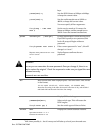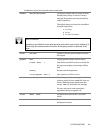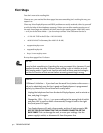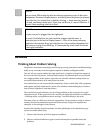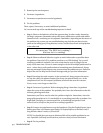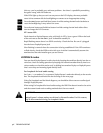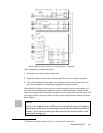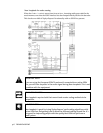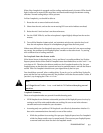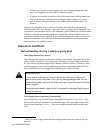
9-4 TROUBLESHOOTING
3. Round up the usual suspects;
4. Generate a hypothesis;
5. Generate an experiment to test the hypothesis;
6. Fix the problem;
Then, repeat, if necessary, to attack additional problems.
Let’s cover each step of the troubleshooting sequence in detail.
• Step 1. Observe the behavior to find the apparent bug. In other words, determine
the bug’s symptoms. Remember always that many problems are subtle and exhibit
themselves via a confusing set of symptoms. Remember, depending on the nature of
the problem, the system you are troubleshooting may include your data circuits,
yours or the calling party’s long distance carrier, and the data circuit and equipment
at the other end.
It’s never just “The ISDN isn’t working”...
but how isn’t it working?
• Step 2. Observe collateral behavior to gain as much information as possible about
the problem. Does the LCD’s problem correlate to an LED flashing? Try to avoid
studying a problem in isolation, but at the same time be wary of trying to fix too
many at the same time. No one is smart enough to deal with multiple problems all at
once – unless they are all manifestations of something more fundamental. Always
note any messages ZephyrExpress may present when the problem occurs. Enlist the
help of the users to keep track of these messages and give you this information.
• Step 3. Round up the usual suspects. At the system level, always suspect the menu
set-up, the cables, the phone company line setup, the punch-blocks, etc. At the
component level, lots of computer problems stem from the same few sources.
Never, never, never forget to check Vcc.
• Step 4. Generate a hypothesis. Before changing things, formulate a hypothesis
about the cause of the problem. You probably don’t have the information to do this
without gathering more data.
Sometimes you’ll have no clue what the problem might be. Sometimes, when the
pangs of desperation set in, it’s worthwhile to try anything practically at random. You
might find a bad plug, an unconnected line, or something unexpected. Look
around, but be always on the prowl for a working hypothesis.
• Step 5. Generate an experiment to test the hypothesis. Plug this ZephyrExpress into a
known good line; call a known good Zephyr or ZephyrExpress at the other end; if
long-distance doesn’t work, try a local call.
NOTE: You should plan your tests to eliminate 50% of the possible problems in one
test, if possible. Just keep careful track so you know what you have eliminated.
• Step 6. Fix the problem.




